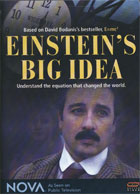
Einstein's Big Idea 2005
Distributed by WGBH Boston, 125 Western Avenue, Boston, MA 02134; 617-300-2000
Produced by NOVA / Darlow Smithson Productions
Directed by Gary Johnstone
DVD, color, 112 min.
Sr. High - Adult
Physics, Mathematics, History, Biography
Date Entered: 12/21/2005
Reviewed by Tim Bryant, E. H. Butler Library, State University of New York College at Buffalo, Buffalo, NYOriginally aired by PBS on October 11, 2005, the 100-year anniversary of the publication of Einstein's equation, this documentary traces four major areas of scientific development leading to the four parts of Einstein's famous equation. Based on David Bodanis's book E=mc2 A Biography of the World's Most Famous Equation, the program reviews the history and explains the science of discoveries concerning energy (E) by Michael Faraday and James Clerk Maxwell, those on matter (m) by Antoine-Laurent Lavoisier, the mathematical findings on squaring (2) by Emilie du Châtelet, Einstein's own work on light (c), and the subsequent work by Lise Meitner and Otto Hahn to split the atom. Actor John Lithgow's brief narration efficiently establishes the historical and logical bridges among these scientific discoveries, portrayed as dramatic reenactments of the story of a scientist working in his or her historical period, while leading experts, including the writer Bodanis and seven professors, provide more in-depth discussion on the scientific and social implications of their work. Production levels, including picture quality, acting, and editing, are high. Scripting is especially fine; repeatedly, reenactments communicate not just technical or logical developments, but the sense of importance and struggle under which these thinkers approached their work. Depictions of those struggles include discrimination based on class (Faraday), gender (du Châtelet), and ethnicity (Meitner). After brief discussion of the World War II bombings of Hiroshima and Nagasaki, made possible by nuclear fission, the program concludes by emphasizing positive applications of the famous equation: nuclear power and mapping the origins of the Big Bang. Educators may find value in screening in whole or in parts, as the various stages of discovery are nicely contained in discrete sections.